LIBER O
vel
Manus et Sagittæ
sub figurâ VI
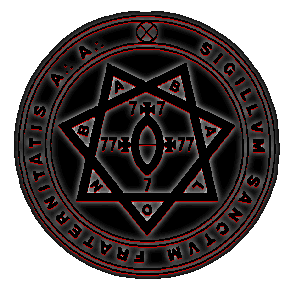
A∴A∴
Publication in Class B
I
- This book is very easy to misunderstand; readers are aksed to use the most minute critical care in the study of it, even as we have done in its preparation.
- In this book it is spoken of the Sephiroth and the Paths; of Spirits and Conjurations; of Gods, Spheres, Planes, and many other things which may or may not exist.
It is immaterial whether these exist or not. By doing certain things certain results will follow; students are most earnestly warned against attributing objective reality or philosophical validity to any of then.
- The advantages to be gained from them are chiefly these:
- A widening of the horizon of the mind.
- An improvement of the control of the mind.
- The student, if he attains any success in the following practices, will find himself confronted by things (ideas or beings) too glorious or too dreadful to be described. It is essential that he remain the master of all he beholds, hears or conceives; otherwise he will be the slave of illusion and the prey of madness.
Before entering on any of these practices, the student should be in good health, and have attained a fair mastery of Asana, Pranayama and Dharana.1
- There is little danger that any student, however idle or stupid, will fail to get some result; but there is great danger that he will be led astray, obsessed and overwhelmed by his results, even though it be by those which it is necessary that he should attain. Too often, moreover, he mistaketh the first resting-place for the goal, and taketh off his armour as if he were a victor ere the fight is well begun.
It is desirable that the student should never attach to any result the importance which it at first seems to possess.
- First, then, let us consider the Book 777 and its use; the preparation of the Place; the use of the Magic Ceremonies; and finally the methods which follow in Chapter V. “Viator in Regnis Arboris,”2 and in Chapter VI. “Sagitta trans Lunam.”3
(In another book will it be treated of the Expansion and Contraction of Consciousness; progress by slaying the Cakkrâms; progress by slaying the Pairs of Opposites; the methods of Sabhapaty Swami, &c. &c.4
II
- The student must FIRST obtain a thorough knowledge of Book 777, especially of columns i., ii., iii., v., vi., vii., ix., xi., xii., xiv., xv., xvi., xvii., xviii., xix., xxxiv., xxxv., xxxviii., xxxix., xl., xli., xlii., xlv., liv., lv., lix., lx., lxi., lxiii., lxx., lxxv., lxxvii., lxxviii., lxxix., lxxx., lxxxi., lxxxiii., xcvii., xcviii., xcix., c., ci., cxvii., cxviii., cxxxvii., cxxxviii., cxxxix., clxxv., clxxvi., clxxvii., clxxxii.5
When these are committed to memory, he will begin to understand the nature of these correspondences. (See Illustrations: “The Temple of Solomon the King,” in Equinox vol. I no. 2. Cross-references are given.)
- If we take an example the use of the table will become clear.
Let us suppose that you wish to obtain knowledge of some obscure science.
In column xlv., line 12, you will find “Knowledge of Sciences.”
By now looking up line 12 in the other columns, you will find that the Planet corresponding is Mercury, its number eight, its lineal figures the octagon and octagram, the God who rules that planet Thoth, or in Hebrew symbolism Tetragrammaton Adonai and Elohim Tzabaoth, its Archangel Raphael, its Choir of Angels Beni Elohim, its Intelligence Tiriel, its Spirit Taphtatharath, its colours Orange (for Mercury is the sphere of the Sephira Hod, 8), Yellow, Purple, Grey, and Indigo rayed with Violet; its Magical Weapon the Wand or Caduceus, its Perfumes Mastic and others, its sacred plants Vervain and others, its jewel the Opal or Agate, its sacred animal the Snake, &c. &c.
- You would then prepare your Place of Working according. In an orange circle you would draw an eight-pointed star of yellow, at whose points you would place eight lamps. The Sigil of the Spirit (which is to be found in Cornelius Agrippa6 and other books) you would draw in the four colours with such other devices as your experiences may suggest.
- And so on. We cannot here enter at length into all the necessary preparations; and the student will find them fully set forth in the proper books, of which the “Goetia” is perhaps the best example.
These rituals need not be slavishly imiated; on the contrary the student should do nothing the object of which he does not understand; also, if he have any capacity whatever, he will find his own crude rituals more effective than the highly polished ones of other people.
The general purpose of all this preparation is as follows:
- Since the student is a man surrounded by material objects, if it be his wish to master one particular idea, he must make every material object about him directly suggest that idea. Thus in the ritual quoted, if his glance fall upon the lights, their number suggests Mercury; he smells the perfumes, and again Mercury is brought to his mind. In other words, the whole magical apparatus and ritual is a complex system of mnemonics.
[The importance of these lies principally in the fact that particular sets of images that the student may meet in his wanderings correspond to particular lineal figures, divine names, &c., and are controlled by them. As to possibility of producing results external to the mind of the seer (objective, in the orindary common-sense acceptation of the term) we are here silent.]
- There are three important practices connected with all forms of ceremonial (and the two Methods which later we shall describe). These are:
(1) Assumption of God-forms.
(2) Vibrations of Divine Names.
(3) Rituals of “Banishing” and “Invoking.”
These, at least, should be completely mastered before the dangerous Methods of Chapters V. and VI. are attempted.
III
- The Magical Images of the Gods of Egypt7 should be made throughly familiar. This can be done by studying them in any public museum, or in such books as may be accessible to the student.8 They should then be carefully painted by him, both from the model and from memory.
- The student, seated in the “God” position, or in the characteristic attitude of the God desired, should then imagine His image as coinciding with his own body, or as enveloping it. This must be practiced until mastery of the image is attained, and an identity with it and with the God experienced.
It is a matter for very great regret that no simple and certain tests of success in this practice exist.
- The vibration of God-names. As a further means of identifying the human consciousness with that pure portion of it which man calls by the name of some God, let him act thus:
- (a) Stand with arms outstretched. (See Illustration).9
(b) Breathe in deeply through the nostrils, imagining the name of the God desired entering with the breath.
(c) Let that name descend slowly from the lungs to the heart, the solar plexus, the navel, the generative organs, and so to the feet.
(d) The moment that it appears to touch the feet, quickly advance the left foot about 12 inches, throw forward the body, and let the hands (drawn back to the side of the eyes) shoot out, so that you are standing in the typical position of the God Horus,* and at the same time imagine the Name as rushing up through the body, while you breathe it out through the nostrils with the air which has been till then retained in the lungs. All this must be done with all the force of which you are capable.
(e) Then withdraw the left foot, and place the right forefinger (or the thumb, the fingers being closed. The thumb symbolizes spirit, the forefinger the element of water), so that you are in the characteristic position of the God Harpocrates.†
- It is a sign that the student is performing this correctly when a single "Vibration" entirely exhausts his physical strength. It should cause him to grow hot all over, or to perspire violently, and it should so weaken him that he will find it difficult to remain standing.
- It is a sign of success, though only by the student himself is it perceived, when he hears the name of the God vehemently roared forth, as if by the concourse of ten thousand thunders; and it should appear to him as if that Great Voice proceeded from the Universe, and not from himself.
In both the above practices all consciousness of anything but the God-form and name should be absolutely blotted out; and the longer it takes for normal perception to return, the better.
* See Illustration in Equinox Vol. I. No. 1, “Blind Force.”
† See Illustration in Equinox Vol. I. No. 1, “The Silent Watcher.”
IV
- The rituals of the Pentagram and Hexamgram must be committed to memory. They are as follows:
The Lesser Ritual of the Pentagram
| (i) | Touching the forehead, say Ateh (Unto Thee). |
| (ii) | Touching the breast,10 say Malkuth (The Kingdom). |
| (iii) | Touching the right shoulder, say ve-Geburah (and the Power). |
| (iv) | Touching the left shoulder, say ve-Gedulah (and the Glory). |
| (v) | Clasping the hands upon the breast, say le-Olahm, Amen (to the Ages, Amen). |
| (vi) | Turning to the East, make a Pentagram (that of Earth) with the proper weapon (usually the Wand). Say (i.e., vibrate) I H V H. |
| (vii) | Turning to the South, the same, but say A D N I. |
| (viii) | Turning to the West, the same, but say A H I H. |
| (ix) | Turning to the North, the same, but say A G L A. |
| Pronounce: Ye-ho-wau, Adónai, Eheieh, Agla.11 |
| (x) | Extending the arms in the form of a Cross,12 say: |
| (xi) | Before me Raphael; |
| (xii) | Behind me Gabriel; |
| (xiii) | On my right hand Michael; |
| (xiv) | On my left hand Auriel; |
| (xv) | For about me flames the Pentagram; |
| (xvi) | And in the Column stands the six-rayed Star. |
| (xvii–xxi) | Repeat (i) to (v), the “Qabalistic Cross.” |
The Greater Ritual of the Pentagram
The pentagrams are traced in the air with the sword or other weapon, the name spoken aloud, and the signs used, as illustrated.
| The Pentagrams of Spirit | |
|---|
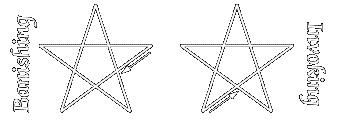 | Equilibrium of Actives,
Names: A H I H (Eheieh). |
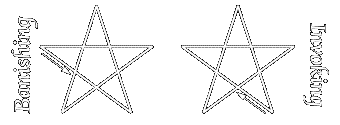 | Equilibrium of Actives,
Names: A G L A (Agla). |
The signs of the Portal (see Illustrations): Extend the hands in front of you, palms outwards, separate them as if in the act of rending asunder a veil or curtain (actives), and then pring them together as if closing it up again and let them fall to the side (passives).13
(The Grade of the “Portal” is particularly attributed to the element of Spirit; it refers to the Sun; the paths of Samekh, Nun, and Ayin14 are attributed to this degree. See “777,” lines 6 and 31 bis.).
| The Pentagram of Fire | |
|---|
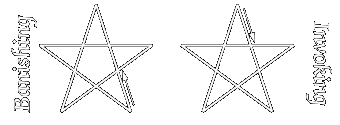 | Name: A L H I M (Elohim). |
The sign of 4°=7°: Raise the arms above the head and join the hands so that the tips of the fingers and of the thumbs meet, formulating a triangle. (See Illustration).
(The Grade of 4°=7° is particularly attributed to the element Fire; it refers to the planet Venus; the paths of Qoph, Tzaddi, and Pé are attribtued to this degree. For other attributions see “777,” lines 7 and 31.).
| The Pentagram of Water | |
|---|
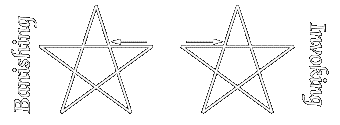 | Name: A L (El). |
The sign of 3°=8°: Raise the arms till the elbows are on a level with the shoulders, bring the hands across the chest, touching the thumbs and tips of fingers so as to form a triangle apex downwards. (See Illustration).
(The Grade of 3°=8° is particularly attributed to the element of Water; it refers to the planet Mercury; the paths of Resh and Shin are attribtued to this degree. For other attributions see “777,” lines 8 and 23.).
| The Pentagram of Air | |
|---|
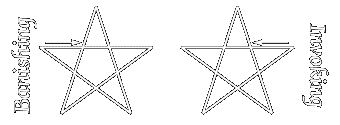 | Name: I H V H (Ye-ho-wau). |
The sign of 2°=9°: Stretch both arms upwards and outwards, the elbows bent at right-angles, the hands bent back, the palms upwards as if supporting a weight. (See Illustration).
(The Grade of 2°=9° is particularly attributed to the element Air; it refers to the Moon; the path of Tau is attribtued to this degree. For other attributions see “777,” lines 9 and 11.).
| The Pentagram of Earth | |
|---|
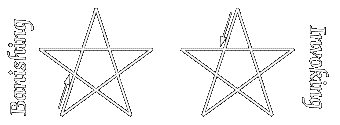 | Name: A D N I (Adonai). |
The sign of 1°=10°: Advance the right foot, stretch out the right hand upwards and forwards, the left hand downwards and backwards, the palms open. (See Illustration).
(The Grade of 1°=10° is particularly attributed to the element of Earth. See “777,” lines 10 and 32 bis.).
The Lesser Ritual of the Hexagram
This ritual is to be performed after the “Lesser Ritual of the Pentagram.”
| (i) | Stand upright, feet together, left arm at side, right arm across body, holding the wand or other weapon upright in the median line. Then face East, and say: |
| (ii) | I. N. R. I.
Yod. Nun. Resh. Yod.
Virgo, Isis, Mighty Mother.
Scorpio, Apophis, Destroyer.
Sol, Osiris, Slain and Risen.
Isis, Apophis, Osiris, IAO15 |
| (iii) | Extend the arms in the form of a cross, and say: “The sign of Osiris Slain.” (See Illustration.) |
| (iv) | Raise the right arm to point upwards, keeping the elbow square, and lower the left arm to point downwards, keeping the elbow square, while turning the head over the left shoulder loowing down so that the eyes follow the left forearm, and say: “The sign of the Mourning of Isis.” (See Illustration.) |
| (v) | Raise ther arms at an angle of sixty degrees to each other above the head, which is thrown back, and say: “The sign of Apophis and Typhon.” (See Illustration.) |
| (vi) | Cross the arms on the breast, and bow the head, and say: “The sign of Osiris Risen.” (See Illustration.) |
| (vii) | Extend the arms again as in (iii) and cross them again as in (vi), saying: “L.V.X., Lux, the Light of the Cross.” |
 |
(viii) With the magical weapon trace the Hexagram of Fire in the East, saying: “ARARITA” ( ). ).
Which word consists of the initials of a sentence which means “One is his Beginning: One is His Individuality: His Permutation is One.”
This hexagram consists of two equilateral triangles, both apices pointing upwards. Begin at the top of the upper triangle and trace it in a dextro-rotary direction. The top of the lower triangle should coincide with the central point of the upper triangle. |
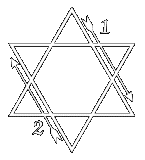 |
(ix) Trace the Hexagram of Earth in the South, saying: “ARARITA.”
This Hexagram has the apex of the lower triangle pointing downwards, and it should be capable of inscription in a circle. |
 |
(x) Trace the Hexagram of Air in the West, saying: “ARARITA.”
This Hexagram is like that of Earth; but the bases of the triangles coincide, forming a diamond. |
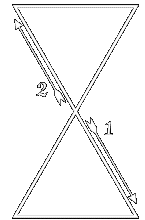 |
(x) Trace the Hexagram of Water in the North, saying: “ARARITA.”
This Hexagram has the lower triangle placed above the upper, so that their apices coincide. |
|
| (xii) | Repeat (i-vii)
The Banishing Ritual is identical, save that the direction of the Hexagrams must be reversed.16 |
The Greater Ritual of the Hexagram
To invoke or banish planets or zodiacal signs.
The Hexagram of Earth alone is used. Draw the hexagram, beginning from the point which is attributed to the planet you are dealing with. (See “777,” col. lxxxiii.)
Thus to invoke Jupiter begin from the right-hand point of the lower triangle, dextro-rotary, and complete; then trace the upper triangle from its left-hand point and complete.
Trace the astrological sigil of the planet in the centre of your hexagram.
For the Zodiac use the hexagram of the planet which rules the sign you require (“777,” col. cxxxviii.); but draw the astrological sigil of the sign, instead of that of the planet.
For Caput and Cauda Draconis use the lunar hexagram, with the sigil of  or
or 
To banish reverse the hexagram.
In all cases use a conjuration first with Ararita, and next with the name of the God corresponding to the planet or sign you are dealing with.17
The Hexagrams pertaining to the planets are as in the figure following:18

- These rituals should be practised until the figures drawn appear in flame, in flame so near to physical flame that it would perhaps be visible to the eyes of a bystander, were one present. It is alleged that some persons have attained the power of actually kindling fire by these means. Whether this be so or not, the power is not one to be aimed at.
- Success in “banishing” is known by a “feeling of cleanliness” in the atmosphere; success in “invoking” by a “feeling of holiness.” It is unfortunate that these terms are so vauge.
But at least make sure of this: that any imaginary figure or being shall instantly obey the will of the student, when he uses the appropriate figure. In obstinate cases, the form of the appropriate God may be assumed.
- The banishing rituals should be used at the commencement of any ceremony whatever. Next, the student shall use a general invocation, such as the “Preliminary Invocation” in the “Goetia,” as well as a special invocation to suit the nature of his working.
- Success in these verbal invocations is so subtle a matter, and its grades so delicately shaded, that it must be left to the good sense of the student to decide whether or not he should be satisfied with his result.
V
- Let the student be at rest in one of his prescribed positions, having bathed and robed with the proper decorum. Let the Place of Working be free from all disturbance, and let the preliminary purifications, banishings and invocations be duly accomplished, and, lastly, let the incense be kindled.
- Let him imagine his own figure (prefereably robed in the proper magical garments and armed with the proper magical weapons) as enveloping his physical body, or standing near to and in front of him.
- Let him then transfer the seat of his consciousness to that imagined figure, so that it may seem to him that he is seeing with its eyes, and hearing with its ears.
This will usually be the great difficulty of the operation.
- Let him then cause that imagined figure to rise in the air to a great height above the earth.
- Let him then stop and look about him. (It is sometimes difficult to open the eyes.)
- Probably he will see figures approaching him, or become conscious of a landscape.
Let him speak to such figures, and insist upon being answered, using the proper pentagrams and signs, as previously taught.
- Let him travel about at will, either with or without guidance from such figure or figures.
- Let him further employ such special invocations as will cause to appear the particular places he may with to visit.
- Let him beware of the thousand subtle attacks and deceptions that he will experience, carefully testing the truth of all with whom he speaks.
Thus a hostile being may appear clothed with glory; the appropriate pentagrams will in such a case cause him to shrivel or decay.
- Practice will make the student infinitely wary in these matters.
- It is usually quite easy to return to the body; but should any difficulty arise, practice (again) will make the imagination fertile. For example, one may create in thought a chariot of fire with white horses, and command the charioteer to drive earthwards.
It might be dangerous to go too far, or stay too long, for fatigue must be avoided.
The danger spoken of is that of fainting, or of obsession, or loss of memory or other mental faculty.
- Finally, let the student cause his imagined body in which he supposes himself to have been travelling to coincide with the physical, tightening his muscles, drawing in his breath, and putting his forefinger to his lips. Then let him “awake” by a well-defined act of will, and soberly and accurately record his experiences.
It may be added that this apparently complicated experiment is perfectly easy to perform. It is best to learn by “travelling” with a person already experienced in the matter. Two or three experiments should suffice to render the student confident and even expert. See also “The Seer,” Equinox vol. I no. 2, pp. 295–333.
VI
- The previous experiment has little value, and leads to few results of importance. But it is susceptible of a development which merges into a form of Dharana—concentration—and as such may lead to the very highest ends. The principal use of the practice in the last chapter is to familiarise the student with every kind of obstacle and every kind of delusion, so that he may be perfect master of every idea that may arise in his brain, to dismiss it, to transmute it, to cause it instantly to obey his will.
- Let him then begin exactly as before; but with the most intense solemnity and determination.
- Let him be very careful to cause his imaginary body to rise in a line exactly perpendicular to the earth's tangent at the point where his physical body is situated (or, to put it more simply, straight upwards).
- Instead of stopping, let him continue to rise until fatigue almost overcomes him. If he should find that he has stopped without willing to do so, and that figure appear, let him at all costs rise above them.
Yea, though his very life tremble on his lips, let him force his way upward and onward!
- Let him continue in this so long as the breath of life is in him. Whatever threatens, whatever allures, though it were Typhon and all his hosts loosed from the pit and leagued against him, though it were from the very Throne of God Himself that a Voice issues bidding him stay and be content, let him struggle on, ever on.
- At last there must come a moment when his whole is swallowed up in fatigue, overwhelmed by its own inertia.* Let him sink (when no longer can he strive, though his tongue be bitten through with the effort and the blood gush from his nostrils) into the blackness of unconsciousness; and then on coming to himself, let him write down soberly and accurately a record of all that hath occurred: yea, a record of all that hath occurred.
* This in case of failure. The results of success are so many and wonderful that no effort is here made to describe them. They are classified, tentatively, in “The Herb Dangerous” Part II. (Equinox Vol. I. no. 2, pp. 31-89).19
Notes
This is based on the version of Liber O in Equinox I (2). References to
illustrations and articles in the Equinox have been changed from relative to absolute.
To reduce download times the plate “The Signs of the Grades” is not included on the present
page. JPEG images of the individual signs are hyperlinked wherever they are referenced; the
whole set may be viewed here.
1: See Liber E for all these.
2: Lat., “The Traveller in the Kingdoms of the Tree” (i.e.,
the Tree of Life).
3: Lat., “The Arrow beyond the Moon.” (The reference is probably to
the Path of Samekh on the Kircher Tree of Life).
4: No single instruction deals with all these subjects. For the Expansion of
Consciousness see Liber DXXXVI (Batrachophrenobookosmomachia), for the Contraction of
Consciousness see Liber Yod (DCCCXXXI) which also treats of “slaying the
Cakkrâms.” The editor of the “Blue Brick” edition of Magick argues that “slaying
the Pairs of Opposites” also falls within the scope of Liber Yod and that “the methods of
Sabhapaty Swami” form the basis for the third section (SSS) of
Liber HHH (CCCXLI).
5: Most of these columns appear in the expanded Appendix V of the “Blue Brick”
edition of Magick, thus:
| 777 | Magick | Description |
| i. | 0 | Key Scale |
| ii., iii. | 1, 2 | Hebrew names of numbers and letters, and English translation thereof. |
| v. | [omitted] | God-names in Assiah. |
| vi., vii. | 9, 11 | Heavens of Assiah and English translation thereof. |
| ix. | 7 | The Sword and the Serpent. |
| xi. | 12 | The Elements (with their Planetary Rulers). |
| xii. | 8 | The Tree of Life. |
| xiv. | 14 | General Attribution of Tarot. |
| xv. – xviii. | 55 – 58 | The Colour Scales. |
| xix. | 24 | Selection of Egyptian Gods. |
| xxxiv. | 26 | Some Greek Gods. |
| xxxv. | 27 | Some Roman Gods. |
| xxxviii. | 28 | Animals, Real and Imaginary. |
| xxxix. | 29 | Plants, Real and Imaginary. |
| xl. | 30 | Precious Stones. |
| xli. | 33 | Magical Weapons. |
| xlii. | 31 | Perfumes. |
| xlv. | 32 | Magical Powers [Western Mysticism]. |
| liv. | 61 | The Letters of the Name. |
| lv. | 60 | The Elements and Senses. |
| lix. | 65 | The Archangels of the Quarters. |
| lx. | [omitted] | The Rulers of the Elements. |
| lxi. | [omitted] | Angels of the Elements. |
| lxiii. | 62 | The Four Worlds. |
| lxx. | 59 | Attribution of Pentagram. |
| lxxv. | 70 | The Five Elements (Tatwas). |
| lxxvii. | 73 | The Planets and their Numbers. |
| lxxviii. | 79 | Intelligences of the Planets. |
| lxxix. | 77 | Spirits of the Planets. |
| lxxx. | [omitted] | Olympic Planetary Spirits. |
| lxxxi. | 74 | Metals. |
| lxxxiii. | 72 | The Attributions of the Hexagram. |
| xcvii., xcviii. | 82, 84 | Parts of the Soul and English translation thereof. |
| xcix. | [omitted] | Archangels of Assiah. |
| c., ci. | [omitted] | Angels of Assiah and English translation thereof. |
| cxvii. | 85 | The Soul (Hindu). |
| cxviii. | 86 | The Chakkras or Centres of Prana (Hinduism). |
| cxxxvii. | 90 | Signs of the Zodiac. |
| cxxxviii. | 91 | Planets ruling signs. |
| cxxxix. | 92 | Planets exalted in signs. |
| clxxv. | 4, 41 | Hebrew letters. |
| clxxvi. | 6, 43 | Numerical Value of Hebrew letters. |
| clxxvii. | 11 | Yetziratic Attributions of Hebrew letters. |
| clxxxii. | [omitted] | The Human Body. |
6: De Occulta Philosophia lib. II cap. xxii. The edition of the
English translation edited by Donald Tyson (St. Paul, Minnestoa: Llewellyn, 1993) has an appendix
explaining how these characters are derived.
7: The reason for using the Egyptian forms is simply that they have the best-defined
Magical Images. There are also techniques for deriving Magical Images from names in Hebrew or
Greek, which can be applied to this practice as well as in the construction of Telesmatic Images.
You should also find out about forms from any other pantheons which particularly appeal to you.
8: See for example Budge's Gods of the Egyptians.
9: A footnote by Crowley at this point in the Magick in Theory and Practice
version of Liber O reads: “This injunction does not apply to gods like Ptah or Harpocrates
whose natures do not accord with this gesture.”
10: This represents the G.D. practice; Crowley later developed a variant of the
Lesser Pentagram ritual which modified this part. For the details and a brief discussion of the
significance of the variations around this point, see “The Thelemic Lesser
Ritual of the Pentagram.”
11: Some practitioners prefer to vibrate IHVH “spelt out” i.e.
as YOD HEH VAU HEH. Similarly, since AGLA is a Notariqon (acronym) of a Hebrew phrase meaning
“Thou art might for ever, Lord” some practioners enunciate each letter distinctly rather
than pronouncing it as a bisyllable.
12: You should turn back to face East before doing this, for reasons explained in
Crowley's notes on the Ritual of the Pentagram.
13: This is generally interpreted as: the Active Equilibrating pentagram with the
name AHIH and the sign of Rending the Veil to be given before the pentagram of Air or Fire, the Passive
Equilibrating pentagram with the name AGLA and the sign of Closing the Veil to be given before the pentagram
of Earth or Water. The G.D. Ritual of the Pentagram (as printed by Regardie) states that “the
saluting sign of the 5°=6° Grade” rather than the Portal signs should be used with the Spirit
Pentagrams. This probably refers to the Sign of Osiris Slain but I am not
totally sure about this. The G.D. also taught a “Supreme Ritual of the Pentragram” the
routine for which in each quarter runs as follows: make appropriate Spirit pentagram while vibrating the
Tablet of Union name (EXARP, BITOM, HCOMA, NANTA) corresponding to the quarter; trace wheel of Spirit symbol
in centre while vibrating AHIH (actives) or AGLA (passives); give Spirit sign; trace Elemental pentagram
while vibrating the 12-letter name from the appropriate Elemental Tablet (ORO IBAH AOZPI, etc. –
see Liber Chanokh); trace Kerubic symbol while vibrating the Hebrew name; give
Elemental sign.
14: In the printed edition the actual Hebrew letters were given here and below.
15: Some practitioners prefer to “vibrate” the Name IAO.
16: The hexagrams shown in this part are all the invoking form. To make the
banishing forms, trace the triangles in the same order and starting from the same point, but trace each
triangle in the opposite direction.
17: See 777, col. v. Generally for the Planets use the name for the Sephirah
corresponding, and for the Signs, the name of the Sephirah corresponding to the ruling Planet. In the
version taught in the Golden Dawn, the letters of ARARITA were attributed to the points of the Hexagram in
“lightning flash” order (A to Saturn, R to Jupiter, A to Mars, etc.) and the particular
letter was to be vibrated along with the other names.
18: The Hexagram of Sol is formed by tracing the hexagrams of the other six planets in
order, thus twelve triangles in total. In the diagram, numbers are placed by the starting point of
the first stroke.
19: Crowley's essay The Psychology of Hashish.
Text of Crowley material © Ordo Templi Orientis. Copies and printouts may be made for
personal use and research and may be distributed to others provided no charge apart from reasonable
costs of copying and postage is made and this notice or an equivalent is included.
Key entry, HTML coding and notes by Frater T.S.
Return to index of documents.








![]() or
or ![]()
